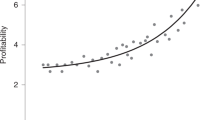Abstract
If males differ in their ability to attract potential mates, and are able to perceive such differences, theory predicts they should distribute themselves in a manner that increases their probability of obtaining potential matings. The relationship between male-male association patterns and the proximity of females in social groups, however, remains virtually unexplored. Experimental analysis of this relationship in the guppy, Poecilia reticulata, demonstrates that in preference tests males showed a strong tendency to associate with other males that were further away from potential mates than they were themselves. Male guppies pursue a behavioral strategy that involves categorizing other males based on their proximity (and possibly relative attractiveness) to females, remembering the identity of such individuals, and using this information when choosing between other males as associates. Such a strategy may increase a male's chances of being the individual chosen by a female assessing nearby males.
Similar content being viewed by others
References
Barkow,JH, Cosmides L, Tooby J (eds) (1992) The adapted mind. Oxford University Press, Oxford
Bradbury JW, Gibson RM (1983) Leks and mate choice. In Bateson P (ed) Mate choice. Cambridge University Press, Cambridge, pp 109–138
Breden F, Stoner G (1987) Male predation risk determines female preference in the Trinidadian guppy. Nature 329:831–833
Brown JL (1969) Territorial behavior and population regulation in birds. Am Nat 103:347–354
Clutton-Brock TH (ed) (1988) Reproductive success. University of Chicago Press, Chicago
Clutton-Brock TH, Hiraiwa-Hasegawa M, Robertson L (1989) Mate choice on fallow deer leks. Nature 340:463–465
Dugatkin LA (1992) Sexual selection and imitation: females copy the mate choice of others. Am Nat 139:1384–1389
Dugatkin LA, Alfieri M (1991) Guppies and the TIT FOR TAT strategy: preference based on past interaction. Behav Ecol Sociobiol 28:243–246
Dugatkin LA, Godin J (1992) Reversal of female mate choice by copying in the guppy (Poecilia reticulata). Proc R Soc Lond B 248:179–184
Dugatkin LA, Wilson DS (1992) The prerequisites of strategic behavior in the bluegill sunfish. Anim Behav 44:223–230
Dugatkin LA, Wilson DS (1993) Partner choice, fish behavior experiments and cognitive ethology. Rev Fish Biol Fish 3:368–372
Dugatkin LA, FitzGerald GJ, Lavoie J (1993) Juvenile threespined sticklebacks avoid parasitized conspecifics. Environ Biol Fishes 39:215–218
Farr J (1989) Sexual selection and secondary sexual differentiation in poeciliids: determinants of male mating success and the evolution of female choice. In: Meffe GK, Snelson FF (eds) Ecology and evolution of livebearing fishes (Poeciliidae). Prentice Hall, New Jersey, pp 91–123
Fellers GM (1979) Mate selection in the gray treefrog, Hyla versicolor. Copein 1979:286–290
Fretwell SD (1972) Populations in a seasonal environment. Princeton University Press, Princeton
Gatz AJ (1981) Non-random mating by size in American toads, Bufo americanus. Anim Behav 29:1004–1012
Höglund J, Robertson JG (1990) Female preferences, male decision rules and the evolution of leks in the great snipe, Gallinago media. Anim Behav 40:15–22
Houde A (1988) Genetic difference in female choice in two guppy populations Anim Behav 36:510–516
Houde AE, Endler JA (1990) Correlated evolution of female mating preference and male color pattern in the guppy, Poecilia reticulata. Science 248:1405–1408
Kennedy C, Endler JA, Poynton S, McMinn H (1987) Parasite load predicts mate choice in guppies. Behav Ecol Sociobiol 21:291–295
Kodric-Brown A (1985) Female preference and sexual selection for male coloration in the guppy. Behav Ecol Sociobiol 17:199–205
Kodric-Brown A (1992) Male dominance can enhance mating success in guppies. Anim Behav 44:165–167
Liley NR (1966) Ethological isolating mechanisms in four sympatric species of poeciliid fishes. Behaviour (Suppl) 31:1–197
Liley NR, Seghers BH (1975) Factors affecting the morphology and behavior of the guppy (Poecilia reticulata) in Trinidad. In: Baerands G, Manning A (eds) Function and behavior in evolution. Oxford University Press, Oxford, pp 92–118
Milinski M, Kulling D, Kettler R (1990) Tit for Tat: sticklebacks “trusting” a cooperating partner. Behav Ecol 1:7–12
Parker G, Sutherland WJ (1986) Ideal free distribution when individuals differ in competitive ability: phenotype-limited ideal free models. Anim Behav 34:1222–1242
Real L (1991) Search theory and mate choice. I. Models of singlesex discrimination. Am Nat 136:376–404
Seghers BH (1973) An analysis of geographic variation in the antipredator adaptations of the guppy, Poecilia reticulata. Ph.D. Thesis, University of British Columbia
Sutherland WJ, Parker G (1985) Distribution of unequal competitors. In: Sibly RM, Smith RH (eds) Behavioural ecology. Blackwell, Oxford, pp 255–274
Wells KD (1977) Territoriality and male mating success in the green tree frog (Rana clamitans). Ecology 58:750–762
Wiley RH (1991) Lekking in birds and mammals: behavioral and evolutionary issues. Adv Study Behav 20:201–291
Author information
Authors and Affiliations
Rights and permissions
About this article
Cite this article
Dugatkin, L.A., Sargent, R.C. Male-male association patterns and female proximity in the guppy, Poecilia reticulata . Behav Ecol Sociobiol 35, 141–145 (1994). https://doi.org/10.1007/BF00171504
Received:
Revised:
Issue Date:
DOI: https://doi.org/10.1007/BF00171504




